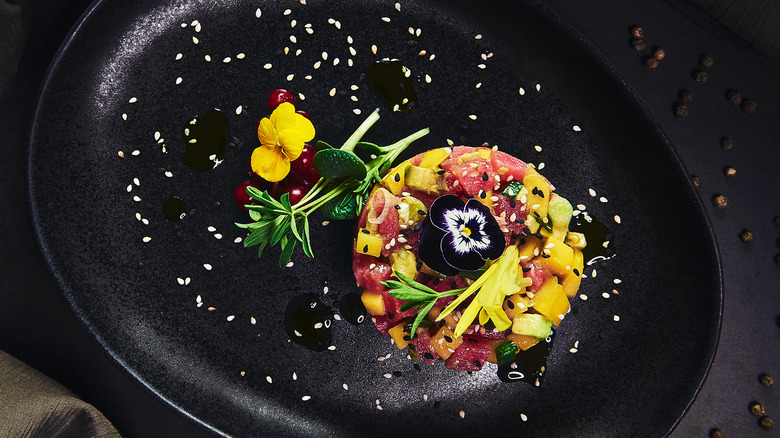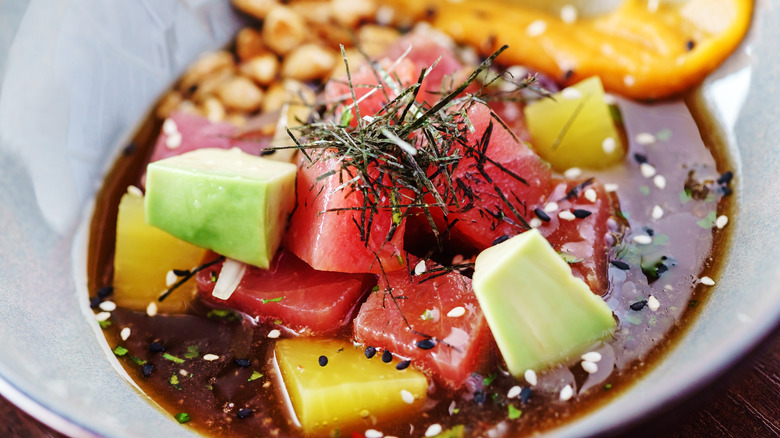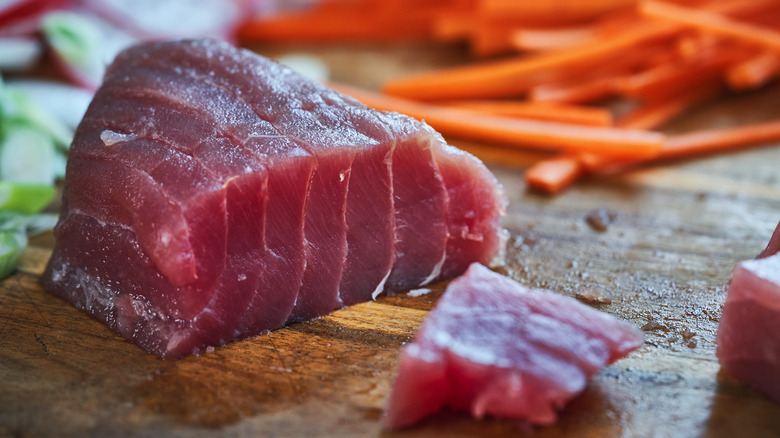Pineapple Is The Sweet Ingredient That Will Transform Your Tuna Tartare
A perfect dish for hot summer evenings, the quintessential appetizer for a dinner party, or a healthy, light option for lunch, a tuna tartare is all about bright, bold flavors geometrically shaped and delicately stacked. It's an impressive, colorful dish gloriously imbued with citrusy lemon juice, the salty aromas of tuna, and, quite often, the creaminess of avocado. While honey may be mixed through for a sweeter sentiment, pineapple also does the trick while simultaneously adding a pop of color.
Fresh pineapple is an exceptionally tropical fruit exploding with juicy, zingy, sweet aromas. Its refreshing flavor is a wonderful way to uplift the rich, salty disposition of the tuna while adding bursting shots of color to the shades of maroon. It gives flavors reminiscent of a Caribbean salad, a Hawaiian poke bowl, and a Latin America ceviche, with a combination of sweet tropical aromas paired with savory fish-based elements. It's a sunshine plate whose appearance matches its dazzling flavor — a dish that can surely not be missed.
Unraveling the flavors
Quantities are essential when forming this tartare, as it needs to be recognized that this is still a tuna tartare — the fish is the star of the show. The beautiful cubes of pineapple break up the shades of tuna, but they should not dominate. Pineapple has a reasonably robust flavor, and using the same amounts of fish as pineapple risks the fruit's flavor overpowering the delicate taste of tuna. Follow a 6:10 ratio of pineapple to tuna, or to calm down these eccentric tropical aromas, mix in milder-fresh tasting ingredients like cucumber or avocado. Mixing these ingredients into your tartare would also add to the color palette, producing beautiful flecks of green.
In terms of sauce, you may seek to bind the pineapple and tuna with a combination of sesame oil and soy sauce for an umami edge that tones down some of the sweeter flavors. If you want to retain the bright colors in the tartare, you may wish to omit the soy sauce and instead opt for a white balsamic, lime juice, and sesame oil blend. This dressing is certain to enhance the raw tuna, tempering some of the pineapple's sweeter notes without diminishing its vibrancy.
Fresh is best
When it comes to the ingredients used in tuna and pineapple tartare, fresh is always best. For tuna, choosing a steak that's considered sushi-grade is recommended, as this usually indicates it is safe to prepare and consume raw. While fresh may taste best, it's not always the most common or affordable. Frozen tuna can be used to make tuna tartare, and it is safe to consume as long as its packaging says it is fit for raw consumption. The thawing of frozen tuna is also a delicate process, as the tuna should be left to defrost in a bowl of iced water over two to three hours. If the water is too warm, the thawing could be rushed. And if the tuna stays in the water too long, you risk losing its deep red color.
For the pineapple, there are several sensory tests to ensure it's ready to eat. Firstly, turn the fruit upside down and smell the bottom. An underripe pineapple will have no or only a faint sweet smell, a ripe pineapple will have a fruity scent, and an overripe pineapple will smell slightly vinegary. If you're unsure about the smell, then give the pineapple a squeeze. It should be somewhat firm but not rock solid. A perfectly ripe pineapple is key, as it'll have that juicy bite and wonderful sunshine flavor. Remember, your tuna deserves the best.
Deliciously zingy, perfectly balanced, and incredibly light, tuna tartare with pineapple is an exceptional combination to serve at just about any time you fancy it.


